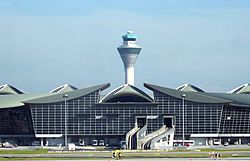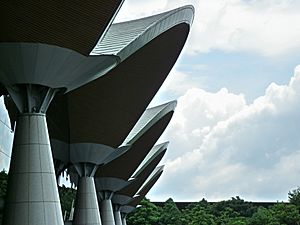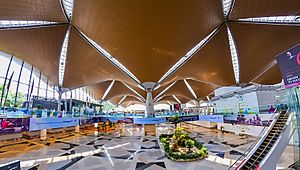Kuala Lumpur International Airport facts for kids
Quick facts for kids
Kuala Lumpur International Airport
Lapangan Terbang Antarabangsa Kuala Lumpur
|
|||||||||||||||||||
|---|---|---|---|---|---|---|---|---|---|---|---|---|---|---|---|---|---|---|---|
 |
|||||||||||||||||||

The KLIA control tower and part of the airport
|
|||||||||||||||||||
| Summary | |||||||||||||||||||
| Airport type | Public | ||||||||||||||||||
| Owner | Government of Malaysia | ||||||||||||||||||
| Operator | Malaysia Airports Holdings Berhad | ||||||||||||||||||
| Serves | Greater Klang Valley | ||||||||||||||||||
| Location | Sepang, Selangor, Malaysia | ||||||||||||||||||
| Hub for |
|
||||||||||||||||||
| Time zone | MST (UTC+08:00) | ||||||||||||||||||
| Elevation AMSL | 70 ft / 21 m | ||||||||||||||||||
| Map | |||||||||||||||||||
| Lua error in Module:Location_map at line 420: attempt to index field 'wikibase' (a nil value). | |||||||||||||||||||
| Runway | |||||||||||||||||||
|
|||||||||||||||||||
| Statistics (2013) | |||||||||||||||||||
|
|||||||||||||||||||
|
Source: AIP Malaysia
|
|||||||||||||||||||
Kuala Lumpur International Airport (KLIA) is Malaysia's main international airport and one of the major airports in Southeast Asia and worldwide. It is located in Sepang District of Selangor, approximately 45 kilometres (28 mi) south of Kuala Lumpur city centre and serves the Greater Klang Valley conurbation.
KLIA is the largest and busiest airport in Malaysia. In 2018, it handled 59,988,409 passengers, 714,669 tonnes of cargo and 399,827 aircraft movements. It is the world's 23rd-busiest airport by total passenger traffic.
The airport is operated by Malaysia Airports (MAHB) and is the major hub of Malaysia Airlines, MASkargo, AirAsia, AirAsia X, Malindo Air, flyGlobal, UPS Airlines and AsiaCargo Express.
History
The ground breaking ceremony for Kuala Lumpur International Airport (KLIA) took place on 1 June 1993 when the government under Mahathir Mohamad decided that the existing Kuala Lumpur airport, then known as Subang International Airport could not handle future demand. It was created as part of the Multimedia Super Corridor, a grand development plan for Malaysia. The chief architect who designed the new airport terminal was the Japanese architect Kisho Kurokawa.
Upon KLIA's completion, Subang Airport's Terminal 1 building was demolished. Malaysia Airports agreed to redevelop the remaining Terminal 3 to create a specialist airport for turboprop and charter planes surrounded by a residential area and a business park.
The airport's site spans 100 square kilometres (39 sq mi) 2, of former agricultural land and is one of the world's largest airport sites. An ambitious three-phase development plan anticipates KLIA to have three runways and two terminals each with two satellite terminals. Phase One involved the construction of the main terminal and one satellite terminal, giving a capacity of 25 million passengers, and two full service runways.
The Phase One airport had sixty contact piers, twenty remote parking bays with eighty aircraft parking positions, four maintenance hangars and fire stations. Phase Two, designed to increase capacity to 35 million passengers per year is largely complete. Phase Three is anticipated to increase capacity to 100 million passengers per year.
Kuala Lumpur International Airport was officially opened by the 10th Yang di-Pertuan Agong, Tuanku Ja'afar of Negeri Sembilan, on 27 June 1998, a week ahead of Hong Kong International Airport and in time for the 1998 Commonwealth Games.
Images for kids
See also
 In Spanish: Aeropuerto Internacional de Kuala Lumpur para niños
In Spanish: Aeropuerto Internacional de Kuala Lumpur para niños










